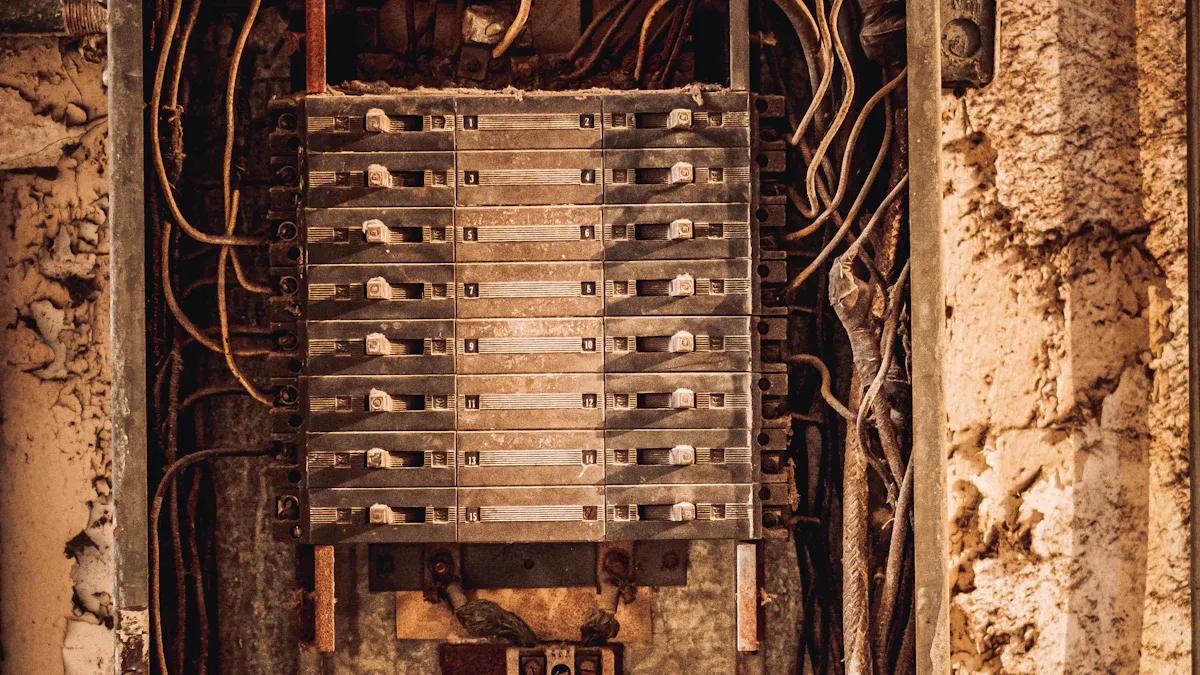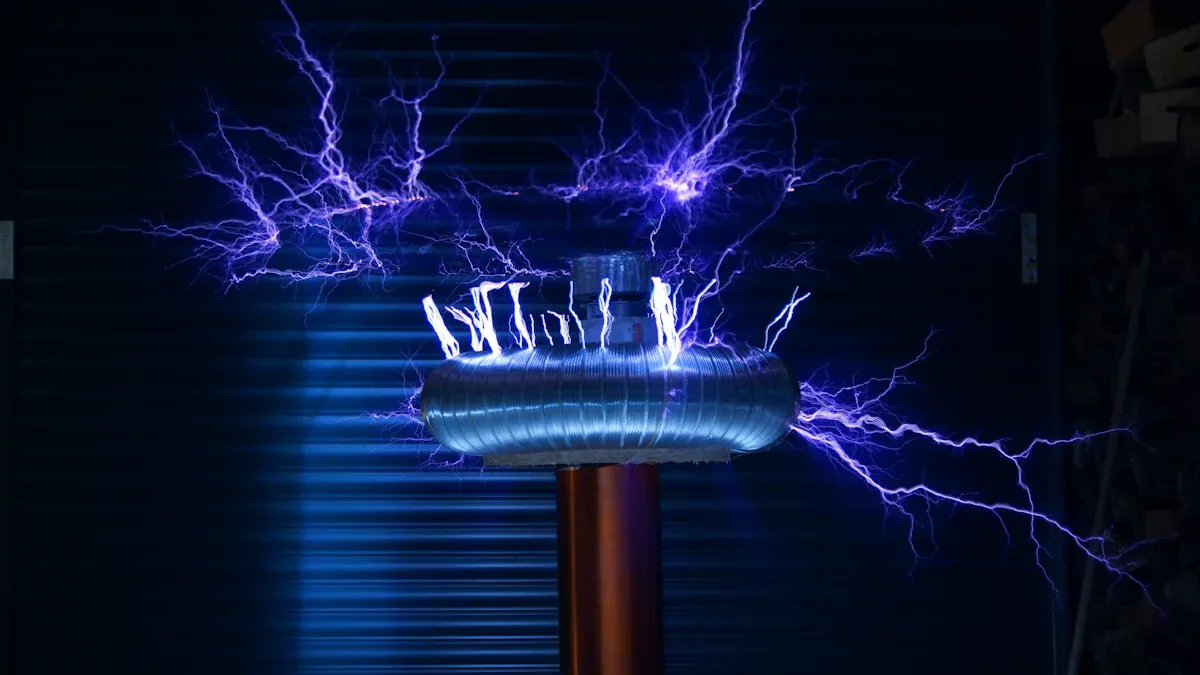You can have three big circuit issues at home: short circuits, circuit overloads, and open circuits. These circuit issues can be dangerous and disrupt your daily life. Every year, these electrical problems cause many house fires in the U.S.
- More than 23,000 fires happen each year from electrical problems.
- Almost 46,000 fires are caused by circuit issues like overloads, short circuits, and open circuits.
Electrical problems are the second biggest reason for house fires. Knowing about these circuit issues helps you keep your home safe and functioning well.
Key Takeaways
- Learn about the three main circuit problems: overloads, short circuits, and open circuits. Knowing these problems helps keep your house safe.
- Stop circuit overloads by using different outlets for big appliances. Do not plug too many things into one outlet. This lowers the chance of a fire.
- Look for signs of short circuits, like breakers that trip or burning smells. If you see these signs, turn off the power. Call an expert right away.
- Check your electrical system often, especially if your house is old. Regular checks can find problems early and save you money.
- Know when to call an electrician. Flickering lights or hot outlets are serious signs. These need help from a professional.
Circuit Overloads

What Is an Overload
A circuit overload happens when you use more electricity than the circuit can handle. Each circuit has a set limit. If you plug in too many things or use big appliances at once, the circuit cannot keep up. This makes the wires get hot. Hot wires can hurt your electrical system and cause safety problems. Circuit overloads are a common circuit issue in homes today.
Recognizing Overloads
You can notice a circuit overload by watching for some signs. The easiest sign is a tripped circuit breaker. When this happens, part of your home loses power. You might see lights flicker or hear outlets buzz. Sometimes, appliances stop working all of a sudden. You may also smell burning or feel warm outlets. These signs mean your circuit is working too hard.
Here is a table showing the most common consequences of circuit overloads:
| Consequence | Description |
|---|---|
| Tripped Circuit Breakers | This is a clear sign of overload and shows there is a problem. |
| Damaged Appliances | Overloading can make appliances too hot and break them. |
| Electrical Fires | Too much heat from overloads can start fires in wires or other things nearby. |
Causes of Overloads
Many things can cause circuit overloads. You might plug too many things into one outlet. Using many big appliances, like heaters or air conditioners, on one circuit can also cause trouble. Old homes may have wiring that cannot handle today’s needs. Broken equipment, loose wires, and sudden changes in voltage can also cause overloads. These circuit issues can happen in any home, old or new.
- Too many things plugged in
- Old wiring
- Broken appliances
- Loose or damaged wires
- Changes in voltage
- Old electrical panels
Preventing Overloads
You can stop circuit overloads by following some easy tips:
Tip: Use different circuits for your appliances so you do not use too much power in one spot.
- Do not put too many plugs in one outlet.
- Use surge protectors for important electronics.
- Check your electrical system often for problems.
- Make sure your wiring and circuit breakers are safe and up to date.
- Change old outlets and wires if needed.
- Get a licensed electrician to check your system.
Circuit breakers help protect your home from circuit issues. They turn off power if there is too much current. This keeps wires from getting too hot and stops fires. If you know what causes overloads and how to stop them, you can keep your home safe from circuit issues.
Short Circuits

What Is a Short Circuit
A short circuit happens when electricity finds a shortcut. It leaves its usual path. This can happen if wires touch each other. It can also happen if something breaks the insulation on wires. Electricity moves fast through the wrong way. This makes wires get very hot. Hot wires can start a fire. Short circuits are one of the most dangerous circuit issues at home.
Signs of Short Circuits
You can find a short circuit by watching for warning signs. These signs can show up quickly. They are easy to see if you pay attention.
- Circuit breakers trip a lot or fuses blow
- You hear popping or buzzing from outlets or walls
- You smell burning, like melted plastic or insulation
- You see black marks on outlets or switches
- Lights flicker or get dim for no reason
- Smoke comes from devices or wall sockets
Tip: If you notice these signs, turn off the power. Call a professional right away.
Causes of Short Circuits
Many things can make short circuits happen at home. Here are some common causes:
- Old or broken wiring that gets damaged
- Too many devices plugged into one circuit
- Water gets into outlets or wiring
- Bad insulation lets wires touch each other
- Loose wires inside outlets or switches
- Appliances with broken wires inside
- Rodents chew insulation and expose wires
Short circuits can happen in new homes or old homes. Even small problems can turn into big circuit issues if not fixed soon.
Preventing Short Circuits
You can help stop short circuits and keep your home safe.
- Get regular electrical checks from a licensed electrician.
- Upgrade your electrical panel if it is too weak.
- Install Arc Fault Circuit Interrupters (AFCIs) to catch arcs.
- Use Ground Fault Circuit Interrupters (GFCIs) in wet places.
- Do not overload outlets or circuits.
- Replace old or broken appliances.
- Keep electrical spots dry and away from water.
- Protect wires from pests by sealing gaps and checking for rodents.
- Use surge protectors for important electronics.
Note: AFCIs and GFCIs are special safety devices. They can stop short circuits before they cause harm.
Open Circuits
What Is an Open Circuit
An open circuit happens when electricity cannot finish its path. This can happen if a wire breaks or a connection is loose. Circuit breakers and fuses use open circuits on purpose to keep your home safe from too much current. But if an open circuit happens by accident, it can cause trouble for your electrical system.
Open circuits can make your home’s electrical system less reliable in different ways:
- They separate broken parts from the rest, which helps stop bigger problems and keeps you safe.
- If an open circuit happens by mistake, it can change voltage and waste power.
- Devices may not work when you need them.
Recognizing Open Circuits
You can find open circuits by watching for some signs. If you see these, you might have an open circuit:
- Outlets or switches that do not work
- Lights that stay off, even with a new bulb
- Appliances that lose power all of a sudden
- Lights that flicker or power that turns on and off
If you notice these signs, check your electrical system. Homeowners should check their electrical systems every 3-5 years. If your house is over 40 years old, check every 2-3 years. You should also get an inspection before buying or selling a house, after big changes, or if you see circuit issues like flickering lights or tripped breakers.
Causes of Open Circuits
Many things can make open circuits happen at home. The table below shows the most common causes:
| Cause Type | Description |
|---|---|
| Component Failure | Broken, damaged, or loose parts can cause open circuits. |
| External Factors | Things like rust or power outages can stop the current. |
| Human Error | Mistakes like unplugging something or wrong wiring can make open circuits. |
Fixing Open Circuits
You can follow some easy steps to fix open circuits safely. Always be careful and wear safety gear.
- Turn off the power and get your tools ready.
- Look for damage near the outlet or switch.
- Use a voltage tester to check if the outlet has power.
- If there is no power, check the wires for a full path.
- Test if the outlet is grounded.
- Tighten all wires and change any broken parts.
- Put everything back and test the outlet again.
Tip: If you are not sure or the problem does not go away, call a licensed electrician. Fixing open circuits stops bigger circuit issues and keeps your home safe.
When to Call a Pro
Warning Signs
You might not know when to call an electrician. Some problems seem small but can be very risky. Watch for these warning signs at home:
- Flickering lights
- Circuit breakers that trip a lot
- Burning smells near outlets or switches
- Outlets that feel hot or shake
- Loose outlets or switches
- Small shocks when you touch appliances
- Wires that look chewed or broken
All these signs can mean a circuit issue. Flickering lights may mean wires are loose or circuits are overloaded. If your circuit breakers keep tripping, there could be a hidden problem. A burning smell is a big warning. It can mean wires or outlets are getting too hot. Hot or shaking outlets need help right away. Loose outlets can make sparks or shocks. If you get a shock or see chewed wires, act fast.
Tip: Do not ignore these signs. Small problems can become big dangers if you wait.
Professional Help
You need a licensed electrician for many circuit issues. A pro knows how to find and fix problems safely. When you pick an electrician, check for these things:
- A real C-10 license, which means the electrician is certified for electrical work
- Proof of bonding and insurance for safety
- Experience with home electrical systems
- Training that is up to date and extra certificates
You should also make sure the electrician’s license is active and the right type. Some electricians have extra certificates. These show they keep learning new safety rules and skills.
Note: Only a licensed electrician should fix serious circuit issues. This keeps your home safe and protects your family from electrical dangers.
Common Circuit Issues
Modern homes have some circuit issues that can hurt safety. These problems can happen more as you add new devices. You might see them when you update your home. Here are the main circuit issues you may find:
- Short circuits: Electricity goes the wrong way. Short circuits can start fires or make power go out.
- Corroded connections: Rust can hurt connections. This wastes energy and breaks appliances.
- Overloaded circuits: Too many devices can overload a circuit. This makes breakers trip.
Preventing Circuit Issues
You can do easy things to stop circuit issues. These steps help keep your home safe. Experts say you should follow these tips:
- Look at cords for damage. Change any that look old or broken.
- Do not put too many plugs in one outlet. Spread devices to other circuits.
- Use the right wattage for bulbs so they do not get too hot.
- Fix circuit breakers that trip a lot. This could mean a bigger problem.
- Put GFCIs in bathrooms, kitchens, and wet places.
- Keep appliances away from water so you do not get shocked.
- Teach kids about electrical safety at home.
- Get pros to do any electrical work.
- Keep your circuit panel safe and easy to reach.
- Check your system often to find problems early.
Regular checks help you find small problems before they get worse. They also keep your system working well and save money on repairs.
New technology can help stop circuit issues. AFCIs and smart breakers find problems fast and turn off power before damage happens. Surge protectors and tamper-resistant outlets give extra safety, especially for homes with kids.
You can use some ways to find circuit issues before they get bad. Looking at your system helps you see burned parts or loose wires. System checks and heat tests show where things get too hot. Smart monitors let you watch your system and find problems early.
You can keep your home safe if you know about circuit problems. Doing regular electrical checks helps in many ways:
- You find dangers early and make your home safer.
- You pay less for energy and repairs.
- Your appliances last longer.
- Your house is worth more.
If you see lights flicker or breakers trip, call an electrician. These steps help your home stay safe and work well for your family.
FAQ
What should you do if your circuit breaker keeps tripping?
You should unplug some devices and reset the breaker. If it trips again, you may have a bigger problem. Call a licensed electrician to check your system for safety.
What is the safest way to check for a circuit issue at home?
Use your senses. Look for flickering lights, listen for buzzing, and smell for burning odors. If you notice any of these, turn off the power and call a professional.
What appliances cause the most circuit overloads?
Large appliances like space heaters, air conditioners, and microwaves often cause overloads. Plug these into separate outlets and avoid using them all at once.
What can you do to prevent short circuits?
Check cords for damage, keep outlets dry, and use surge protectors. Replace old or broken devices. Schedule regular inspections with a licensed electrician.
What signs show you have an open circuit?
You may notice outlets or switches that do not work, lights that stay off, or appliances that lose power suddenly. These signs mean you should check your wiring or call an electrician.
See also
What Causes a Circuit Breaker to Trip Without Restoring Electricity
Understanding a and b Contacts in Circuit Breakers
How to Resolve RCCB Tripping Problems at Home
What Are Main and Arcing Contacts in Circuit Breakers
How to Identify and Fix RCD Tripping Issues



